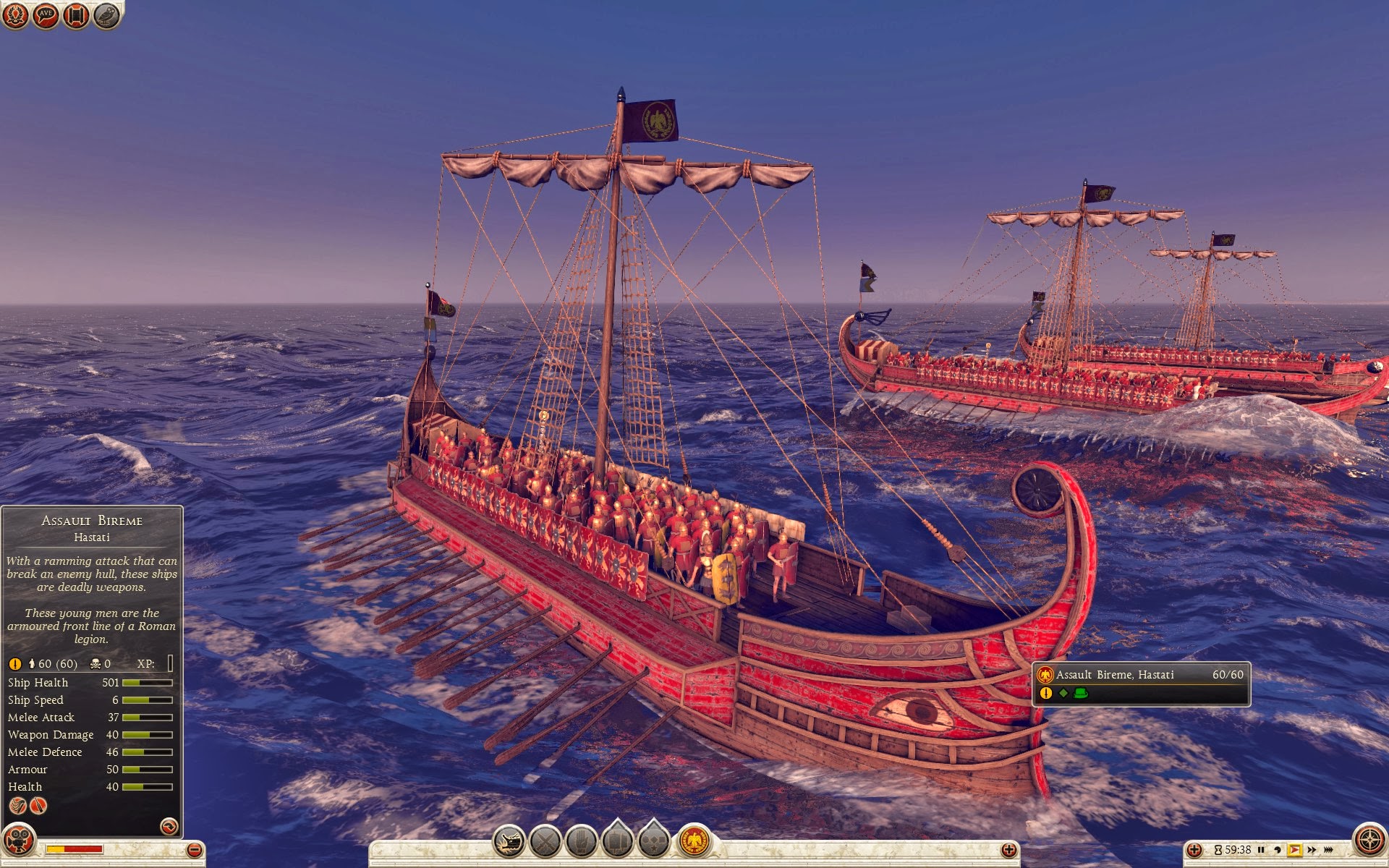Assault Bireme - Hastati
With a ramming attack that can break an enemy hull, these ships are deadly weapons.These young men are the armoured front line of a Roman Legion.
The waterline ram was first mounted on a vessel in around 850BC. Warships and naval tactics were transformed. Ships were no longer platforms for infantry battles on the water; the ship itself became the weapon. Galleys changed as the new reality sank in. Ramming at speed would hole and sink an enemy, therefore slimmer, faster, handier ships were required. More speed on demand obviously required more oars a fast ship with a single row of oars ended up being stupidly, impractically long. The solution, then, was to put in a second set of oars above the first, but slightly offset to allow for rowers' benches. These biremes, a Latin word meaning 'two oars', or dieres, the Greek equivalent, were no longer than previous designs but had twice the number of rowers. They were fast, manoeuvrable, and could carry a fighting contingent. Some nations also gave their bireme crews fire pots; these clay pots filled with oil and pitch were hurled at enemy ships in the entirely reasonable hope of setting them ablaze.
(Hastati)
During the 4th century BC the Romans abandoned the phalanx in favour of armies consisting chiefly of hastati, principes and triarii. These were deployed in maniples: compact blocks of men, arranged in a checkerboard formation. This allowed flexibility when moving across the battlefield, particularly when compared to the sluggish movements of a solid pike phalanx. Like most sophisticated city-states of the ancient world, Rome expected its men to fight, and supply their own war gear when they did so. A cynical observer might be tempted to note that the manipular Legion also made sure that the hierarchy of Rome was preserved. The youngest and least wealthy became hastati, the first line of battle in a Roman Legion. Behind them came the second line of principes, older and richer men, and finally came the triarii, the most experienced warriors. “Going to the triarii” was a Roman saying that came to be used in all kinds of situations, implying that everything else had been tried and found wanting.
日本語化: JapanTotalWarとは
Unit Name Assault Bireme - Hastati |
Main Unit Key Rom_Hastati_Two |
Land Unit Key Rom_Hastati |
Naval Unit Key roman_two |
Soldiers 60 |
Category Light Ship |
Class 近接艦 |
Custom Battle Cost 430 |
Recruitment Cost 430 |
維持費 86 |
Missile Damage 30 |
├ Missile Weapon rome_pilum_light |
├ Projectile pilum_light |
├ Missile Damage 20 |
├ Missile Ap Damage 10 |
└ Base Reload Time 15 |
Accuracy 5 |
Range 40 |
Reload 0 |
Shots Per Minute 4 |
Ammunition 2 |
Ship Health 501 |
└ Ship roman_two |
Ship Speed 6 |
Melee Attack 35 |
Weapon Damage 35 |
├ Melee Weapon rome_gladius |
├ Melee Damage Base 30 |
├ Melee Damage Ap 5 |
├ Armour Piercing No |
├ Bonus vs. Large 0 |
├ Bonus vs Elephants 0 |
└ Bonus vs Infantry 0 |
Charge Bonus 12 |
Melee Defence 48 |
├ Base Defence 18 |
├ Shield scutum |
└ Shield Defence 30 |
Armour 60 |
├ Armour chest |
├ Armour Defence 25 |
└ Shield Armour 35 |
Health 50 |
├ Man Entity rome_infantry_medium |
├ Man Health 40 |
└ Bonus Hit Points 10 |
Base Morale 45 |
Abilities
Assault Bireme- Row Hard 10
Increases speed for 10 strokes.
Ship speed
- Attacking Testudo
The troops of this unit raise their shields above their heads in a defensive formation.
Protection against missiles
Limited speed
Attributes
- 確固たる規律
この部隊は、将軍が死亡しても士気ペナルティを被らない。また、他の部隊よりも敗走後復帰する確率が高い。 - 隊形維持
この部隊は、白兵戦時に隊形を維持しようとする。 - 潜伏 (森)
この部隊は、敵がすぐそばに接近するまで森に潜伏する事ができる。
Strengths & Weaknesses
Assault Bireme- Very poor hull strength
- Very light crew
- Fast speed
- Weak ramming
- Good boarding
- Average attack
- Weak defence
- Average damage but low armour penetration
- Poor morale
| Faction Availability | |
|---|---|
| グランドキャンペーン | |
| サムニウム戦争 | |
| Hannibal at the Gates | |


 English
English Français
Français Italiano
Italiano Deutsch
Deutsch Español
Español Русский
Русский Čeština
Čeština Polski
Polski Türkçe
Türkçe 简体中文
简体中文 正體中文
正體中文



